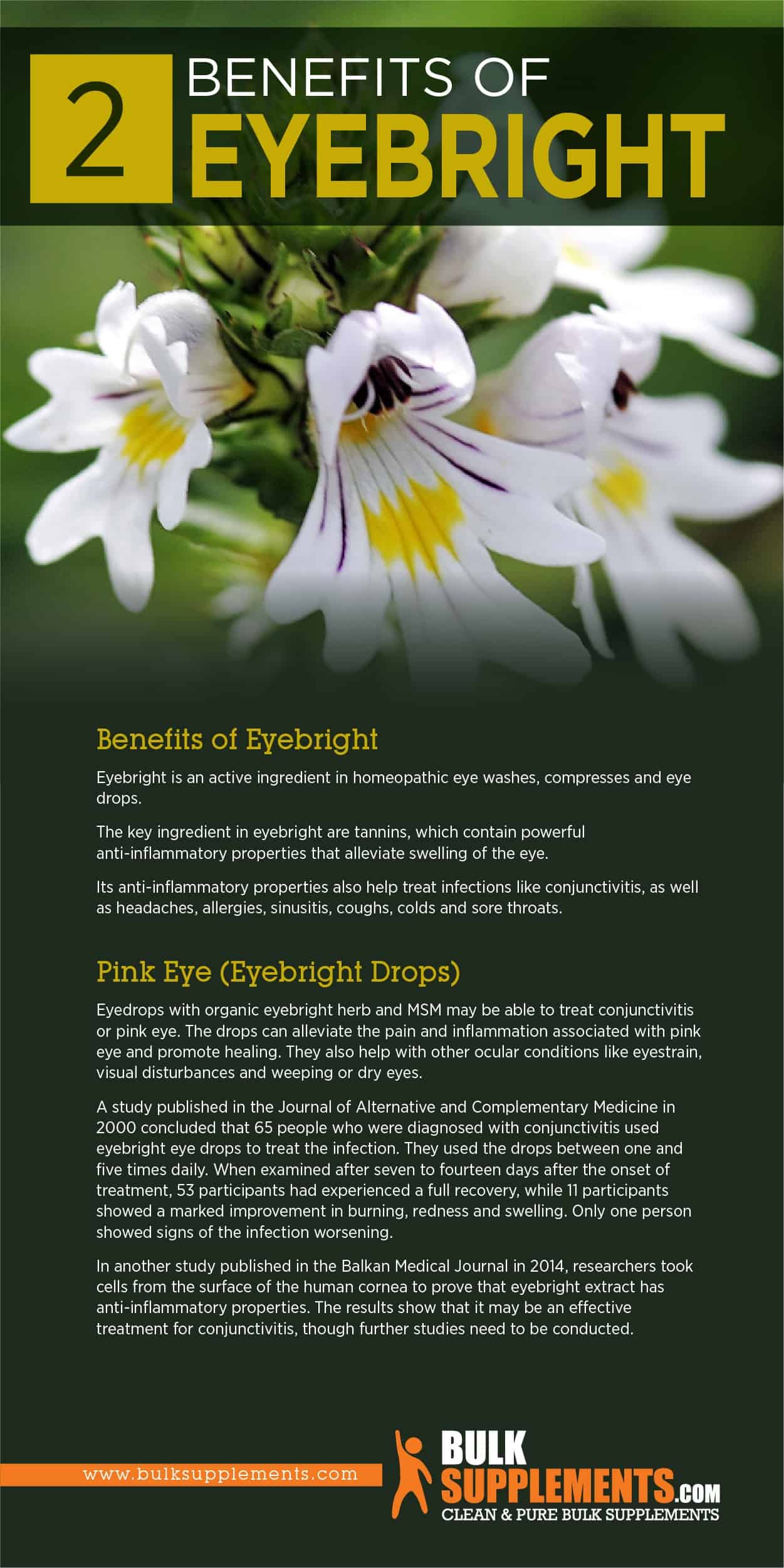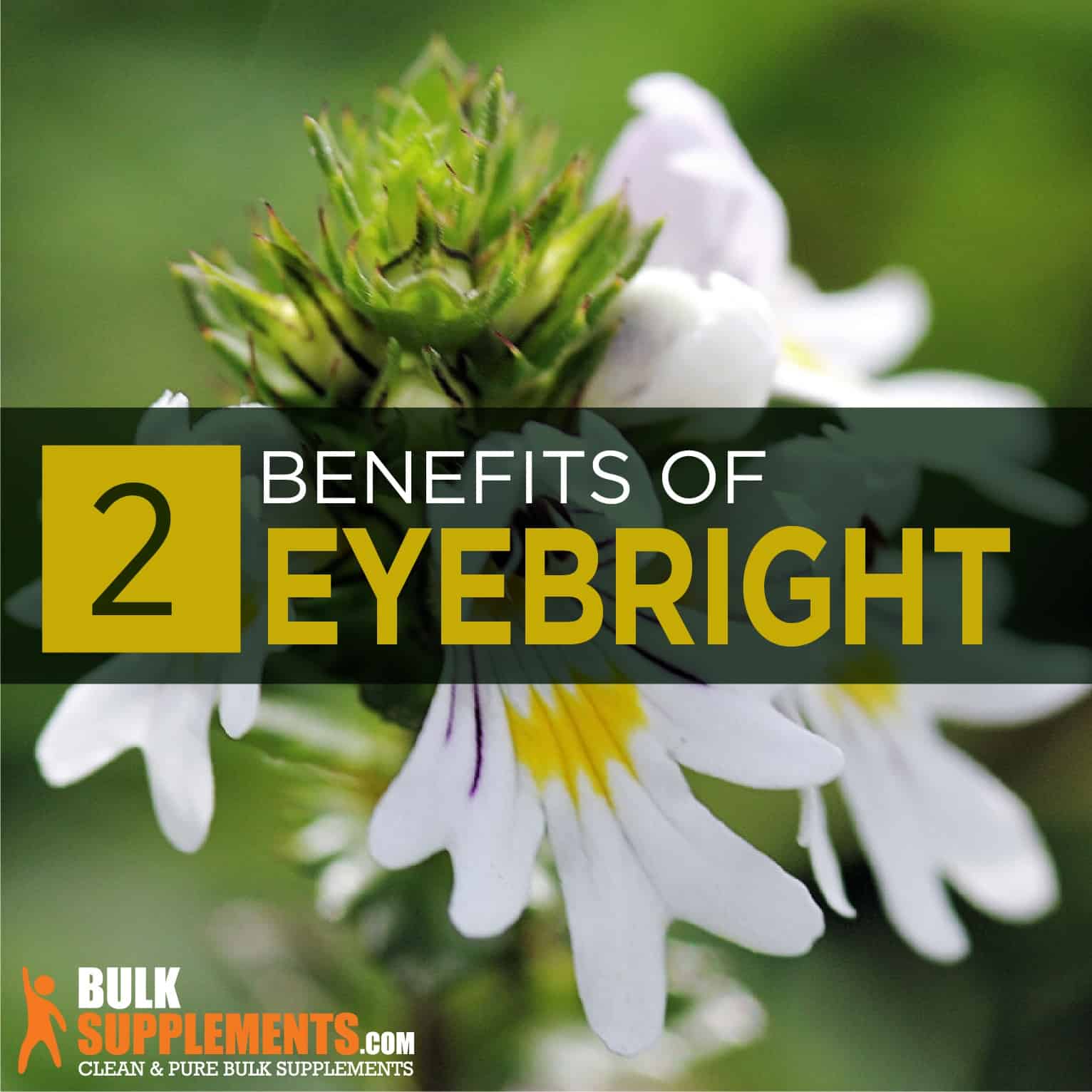What is Eyebright?
Eyebright is a plant that grows in Europe that has been used for medicinal purposes for centuries. The aptly named “eyebright” is a known natural remedy for various eye conditions.
The Eyebright Plant
The eyebright plant is from the Orobanchaceae family, and there are 450 species of the plant. Many of them can be found in sub-alpine or alpine meadows in cold, snowy climates. The flowers of eyebright are unique with the lower end presenting in a lip-like appearance. They are commonly blue-white, violet or purple with yellow marks that act as a landing path for insects to pollinate.
The History of Eyebright
Mention of the eyebright plant was first found in classical herbalist’s literature in 1305 when Nicholas Culpeper associated the plant with the Leo sign of the Zodiac. He also believed that it helped to strengthen the brain. Throughout history, it has been a panacea to treat vertigo and memory issues (x).
During the Elizabethan era, many used eyebright in ales drunk in small amounts in the morning. Herbalists used it for visual problems, redness, swelling and conjunctivitis. It was also taken to relieve inflammation caused by the common cold, hay fever, sore throats and coughs, as well as for the alleviation of eyestrain.
Eyebright Extract
Eyebright extract comes from the leaves, small flowers and stems which are used to make warm compresses or tea.
Benefits of Eyebright
Eyebright is an active ingredient in homeopathic eye washes, compresses and eye drops.
The key ingredient in eyebright are tannins, which contain powerful anti-inflammatory properties that alleviate swelling of the eye.
Its anti-inflammatory properties also help treat infections like conjunctivitis, as well as headaches, allergies, sinusitis, coughs, colds and sore throats.
Pink Eye (Eyebright Drops)
Eyedrops with organic eyebright herb and MSM powder may be able to treat conjunctivitis or pink eye (x). The drops can alleviate the pain and inflammation associated with pink eye and promote healing. They also help with other ocular conditions like eyestrain, visual disturbances and weeping or dry eyes (x).
A study published in the Journal of Alternative and Complementary Medicine in 2000 concluded that 65 people who were diagnosed with conjunctivitis used eyebright eye drops to treat the infection (x). They used the drops between one and five times daily. When examined after seven to fourteen days after the onset of treatment, 53 participants had experienced a full recovery, while 11 participants showed a marked improvement in burning, redness and swelling. Only one person showed signs of the infection worsening.
In another study published in the Balkan Medical Journal in 2014, researchers took cells from the surface of the human cornea to prove that eyebright extract has anti-inflammatory properties (x). The results show that it may be an effective treatment for conjunctivitis, though further studies need to be conducted.

Side Effects of Eyebright
People who wear contact lenses or who have had cataracts removed, laser eye surgery, corneal transplant or other eye conditions may experience side effects after using eyebright. Be sure to consult a physician before using it.
Side effects after using eyebright can include headaches, nausea, sneezing, vision problems and toothache. Avoid using it if you are breastfeeding or pregnant. More research is necessary to determine whether it is safe for pregnant or nursing mothers.
May Lower Blood Sugar Levels
Studies indicate that eyebright may lower blood sugar. People with diabetes should avoid using it as it may reduce blood sugar to a dangerously low level.
May Interfere with Surgical Procedures
It may also interfere with surgical procedures, so stop using eyebright for a minimum of two weeks before you undergo any surgical procedure.
Drug Interactions
Eyebright may interfere with certain medications, so always consult a physician before using it.
Dosage of Eyebright
When supplementing with eyebright extract powder, take 1,000 mg (scant 1/2 tsp) once daily, or as directed by a physician. Of course, be sure to talk to a medical professional ahead of time to determine a better dosage for your personal needs.
Alternatives to Eyebright
Though early results are encouraging, more studies are still necessary to determine eyebright’s true potential. There are a range of alternative options to combat eye problems that may be more effective. Some natural substances may help to alleviate symptoms of eye problems without the risk of adverse reactions.
Omega-3 Fatty Acids
Omega-3 fatty acids can reduce symptoms associated with dry eye syndrome. Research suggests that omega-3 fatty acids (gamma-linolenic acid, docosahexaenoic acid and eicosatetraenoic) may help to curb the discomfort associated with dry eye syndrome (x).
Lutein
Evidence suggests that lutein may help to enhance visual acuity in healthy adults who are experiencing age-related macular degeneration, which is the leading cause of blindness (x). Lutein is present in fresh fruits and vegetables that have deep yellow, orange and green colors. It is also available in supplementation form.
Bilberry
Bilberry is a homeopathic agent that may help treat eye conditions such as glaucoma and protect the eye from problems that are associated with high blood pressure and diabetes (x). Ginkgo biloba is another natural herb that helps with the treatment of glaucoma (x).
Zinc
Zinc is a mineral that naturally occurs in the eye. It works as an antioxidant that helps to reduce the risk of free-radical damage. Supplementing with zinc might help to alleviate conditions of the eye and increase vision (x).
Vitamin B
Vitamin B1 (thiamine) is an essential vitamin for eye health. Research indicates that it might help to reduce your risk of cataracts and inflammation. It might also help to treat uveitis, which is an inflammatory condition of the eye that can result in blindness (x).
Vitamin C
Studies have shown that vitamin C helps to reduce the risk of developing some types of cataracts. In fact, a combination of vitamins E and C may reduce the progression of cataracts and possibly prevent them entirely (x).
The Bottom Line
Eyebright is an extract that comes from the eyebright plant. There are claims that it alleviates eye infections like conjunctivitis and helps with other eye conditions, though more research is necessary to confirm its effects. Possible benefits may not only include increasing general eye health, but even reducing the risk of cataracts and enhancing visual acuity. Do note, though, that side effects may range from lowering blood pressure and interfering with surgical procedures and certain medications to headaches, nausea and sneezing. Avoid using eyebright if you are breastfeeding or pregnant.


